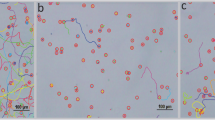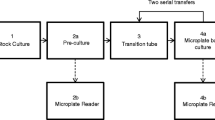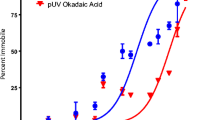Abstract
A rapid, sensitive algal bioassay was investigated to monitor copper toxicity using photosynthetic activity and motility parameters as end points in the photosynthetic flagellate Euglena gracilis. Effects on motility parameters were determined using the automatic bioassay ECOTOX. Photosynthetic efficiency was measured using chlorophyll fluorescence by means of a fast, noninvasive pulse amplitude modulated fluorometer. These parameters were assessed regarding their effectiveness as end points for short- (0–24 h) and long-term (1–5 days) toxicity tests. The model organism showed significant responses to the tested concentrations at both motility and photosynthesis examined levels. EC50 values for movement parameters immediately after the cells were mixed with copper are 19.09 (300.4 μM), 20.4 (312 μM) and 23.09 (363.35 μM) mg L−1 for motility, r-value and velocity, respectively. The current study proofs that Euglena is a convenient biotest organism where motility parameters show rapid sensitive responses to copper (direct exposure to copper). Also, the photosynthetic parameters appear to be appropriate for acute and chronic toxicity tests for higher and lower copper concentrations, respectively.




Similar content being viewed by others
References
Aronsson KA, Ekelund NGA (2005) Effects on motile factors and cell growth of Euglena gracilis after exposure to wood ash solution; assessment of toxicity, nutrient availability and pH-dependency. Water Air Soil Pollut 162:353–368
Baszynski T, Tukendorf A, Ruszkowska M, Skorzynska E, Maksymiec W (1988) Characteristics of the photosynthetic apparatus of copper non-tolerant spinach exposed to excess of copper. J Plant Physiol 132:708–713
Baumann HA, Morrison L, Stengel DB (2008) Metal accumulation and toxicity measured by PAM—chlorophyll fluorescence in seven species of marine macroalgae. Ecotoxicol Environ Saf 72:1063–1075
Brand LE, Sunda WG, Guillard RR (1986) Reduction of marine phytoplankton reproduction rates by copper and cadmium. J Exp Mar Biol Ecol 96:225–250
Braune W, Häder D-P, Hagen C (1994) Copper toxicity in the green alga Haematococcus lacustris: flagellates become blind by copper(II) ions. Cytobios 77:29–39
Checcucci A, Colombetti G, Ferrara R, Lenci F (1976) Action spectra for photoaccumulation of green and colorless Euglena: evidence for identification of receptor pigments. Photochem Photobiol 23:51–54
Coppellotti O (1989) Glutathione, cysteine and acid-soluble thiol levels in Euglena gracilis cells exposed to copper and cadmium. Comp Biochem Physiol 94:35–40
Danilov R, Ekelund N (2001a) Applicability of growth rate, cell shape, and motility of Euglena gracilis as physiological parameters for bioassessment at lower concentrations of toxic substances: an experimental approach. Env Toxicol 16:78–83
Danilov RA, Ekelund NGA (2001b) Using the green flagellate Euglena gracilis Klebs as physiological dosimeter. Is a long-term bioassay more significant than a short-term one? Turk J Bot 25:43–44
De Filippis LF, Hampp R, Ziegler H (1981) The effect of sublethal concentrations of zinc, cadmium and mercury on Euglena. Adenylates and energy charge. Z Pflanzenphysiol 103:1–7
Deloménie C, Foti E, Floch E, Diderot V, Porquet D, Dupuy C, Bonaly J (2007) A new homolog of FocA transporters identified in cadmium-resistant Euglena gracilis. Biochem Biophys Res Commun 358:455–461
dos Santos FV, Conforti V, Bench S, Feldman R, Levin MJ (2007) Gene expression patterns in Euglena gracilis: insights into the cellular response to environmental stress. Gene 389:136–145
Duval E, Coffinet S, Bernard C, Briand J (2005) Effects of two cyanotoxins, microcystin-LR and cylindrospermopsin, on Euglena gracilis. In: Lichtfouse E, Schwarzbauer J, Robert D (eds) Environmental chemistry. Part VII: Green chemistry and pollutants in ecosystems. Springer, Berlin, pp 659–671
Einicker-Lamas M, Soares MJ, Soares MS, Oliveira MM (1996) Effects of cadmium on Euglena gracilis membrane lipids. Braz J Med Biol Res 29:941–948
Einicker-Lamas M, Mezian GA, Fernandes TB, Silva FLS, Guerra F, Miranda K, Attias M, Oliveira MM (2002) Euglena gracilis as a model for the study of Cu2+ and Zn2+ toxicity and accumulation in eukaryotic cells. Environ Pollut 120:779–786
Eisner D, Fomin A (2002) A new approach for biological online testing of stack gas condensate from municipal waste incinerators. Environ Sci Pollut Res 9:262–266
Fatoki OS, Mathabatha S (2001) An assessment of heavy metal pollution in the East London and Port Elizabeth harbours. Water SA 27:233–240
Fernandes JC, Henriques FS (1991) Biochemical, physiological and structural effects of excess copper in plants. Bot Rev 57:246–273
Fomina M, Ritz K, Gadd GM (2000) Negative fungal chemotropism to toxic metals. FEMS Microbiol Lett 193:207–211
Gajdosova J, Reichrtova E (1996) Different growth response of Euglena gracilis to Hg, Cd, Cr and Ni compounds. Fresenius' J Anal Chem 354:641–642
Gavis J, Guillard RR, Woodward BL (1981) Cupric ion activity and the growth of phytoplankton clones isolated from different marine environments. J Mar Res 39:315–333
Häder DP, Liu SM (1990) Effects of artificial and solar UV-B radiation on the gravitactic orientation of the dinoflagellate, Peridinium gatunense. FEMS Microbiol Ecol 73:331–338
Häder DP, Lebert M, Tahedl H, Richter P (1997) The Erlanger flagellate test (EFT): photosynthetic flagellates in biological dosimeters. J Photochem Photobiol B Biol 40:23–28
Info 04 (1997) Referenzliste Chemikalien für den LUMIStox Leuchtbakterientest [Reference list of chemicals for the LUMIStox luminating bacteria test]. Dr Bruno Lange GmbH, Berlin
Knauert S, Knauer K (2008) The role of reactive oxygen species in copper toxicity to two freshwater green algae. J Phycol 44:311–319
Küpper H, Küpper F, Spiller M (1996) Environmental relevance of heavy metal-substituted chlorophylls using the example of water plants. J Exp Bot 47:259–266
Macfarlane GR, Burchett MD (2001) Photosynthetic pigments and peroxidase activity as indicators of heavy metal stress in the Grey Mangrove, Avicennia marina (Forsk.) Vierh. Mar Pollut Bull 42:233–240
Mallick N, Mohn FH (2003) Use of chlorophyll fluorescence in metal-stress research: a case study with the green microalga Scenedesmus. Ecotox Environ Safety 55:64–69
Millán de Kuhn R, Streb C, Breiter R, Richter P, Neeße T, Häder D-P (2006) Screening for unicellular algae as possible bioassay organisms for monitoring marine water samples. Water Res 40:2695–2703
Nielsen HD, Nielsen SL (2008) Evaluation of imaging and conventional PAM as a measure of photosynthesis in thin- and thick-leaved marine macroalgae. Aquat Biol 3:121–131
Perales-Vela HV, González-Moreno S, Montes-Horcasitas C, Cañizares-Villanueva RO (2007) Growth, photosynthetic and respiratory responses to sub-lethal copper concentrations in Scenedesmus incrassatulus (Chlorophyceae). Chemosphere 67:2274–2281
Pettersson M, Ekelund NGA (2006) Effects of the herbicides Roundup and Avans on Euglena gracilis. Arch Environ Contam Toxicol 50:175–181
Rai PK, Mallick N, Rai LC (1994) Effect of Cu and Ni on growth, mineral uptake, photosynthesis and enzyme activities of Chlorella vulgaris at different pH values. Biomed Environ Sci 7:56–67
Ralph PJ, Burchett MD (1998) Photosynthetic response of Halophila ovalis to heavy metal stress. Environ Pollut 103:91–101
Richter P, Ntefidou M, Streb C, Lebert M, Häder DP (2002a) Physiological characterization of gravitaxis in Euglena gracilis. J Gravitat Physiol 9:279–280
Richter PR, Ntefidou M, Streb C, Faddoul J, Lebert M, Häder DP (2002b) High light exposure leads to a sign change of gravitaxis in the flagellate Euglena gracilis. Acta Protozool 41:343–351
Rocchetta I, Küpper H (2009) Chromium- and copper-induced inhibition of photosynthesis in Euglena gracilis analysed on the single-cell level by fluorescence kinetic microscopy. New Phytol 182:405–420
Schlösser UG (1994) SAG-Sammlung von Algenkulturen at the University of Göttingen. Catalogue of Strains 1994. Bot Acta 107:113–186
Schuler LJ, Hoang TC, Rand GM (2008) Aquatic risk assessment of copper in freshwater and saltwater ecosystems of South Florida. Ecotoxicology 17:642–659
Scordino A, Musumeci F, Gulino M, Lanzanò L, Tudisco S, Sui L, Grasso R, Triglia A (2008) Delayed luminescence of microalgae as an indicator of metal toxicity. J Phys D Appl Phys 41:155507
Shioi Y, Tamai H, Sasa T (1978) Inhibition of photosystem II in the green alga Ankistrodesmus falcatus by copper. Physiol Plant 44:434–438
Stallwitz E, Häder DP (1993) Motility and phototactic orientation of the flagellate Euglena gracilis impaired by heavy metal ions. J Photochem Photobiol B Biol 18:67–74
Stallwitz E, Häder DP (1994) Effects of heavy metals on motility and gravitactic orientation of the flagellate, Euglena gracilis. Eur J Protistol 30:18–24
Starr RC (1964) The culture collection of algae at Indiana University. Am J Bot 51:1013–1044
Stauber JL, Andrade S, Ramirez M, Adams MCJA (2005) Copper bioavailability in a coastal environment of Northern Chile: comparison of bioassay and analytical speciation approaches. Mar Pollut Bull 50:1363–1372
Tahedl HA (2000). Entwicklung eines vollautomatischen Analysesystems für ökotoxikologische Untersuchungen. Dissertation, Friedrich-Alexander University, Erlangen-Nürnberg
Tahedl H, Häder DP (1999a) Fast examination of water quality using the automatic biotest ECOTOX based on the movement behavior of a freshwater flagellate. Water Res 33:426–432
Tahedl H, Häder DP (1999b) Vollautomatische Überprüfung der Wasserqualität durch Bewegungsanalyse eines Einzellers. GIT Labor-Fachz 9:898–902
Tahedl H, Häder DP (2001) Automated biomonitoring using real time movement analysis of Euglena gracilis. Ecotoxicol Environ Saf 48:161–169
Turbak SC, Olson SB, McFeters GA (1986) Comparison of algae assay systems for detecting waterborne herbicides and metals. Water Res 20:91–96
Walsh GE, Merrill RG (1984) Algal bioassays of industrial and energy process effluents. In: Shubert LE (ed) Algae as ecological indicators. Academic, London, pp 237–256
Wang PK, Chang L (1991) Effects of copper, chromium and nickel on growth photosynthesis and chlorophyll a synthesis of Chlorella pyrenoidosa 251. Environ Pollut 72:127–139
Watanabe M, Henmi K, Ogawa K, Suzuki T (2003) Cadmium-dependent generation of reactive oxygen species and mitochondrial DNA breaks in photosynthetic and non-photosynthetic strains of Euglena gracilis. Comp Biochem Physiol C Toxicol Pharmacol 134:227–234
Willemann RL (2002). Development of an application of the ECOTOX system in the Estuarine Zone of the Baía da Babitonga, SC, Brazil. Master thesis, Friedrich-Alexander University Erlangen-Nürnberg, Germany
Williams LE, Pitman JK, Hall JL (2000) Emerging mechanisms for heavy metal transport in plants. Biochem Biophys Acta 1465:104–126
Yruela I, Gatzen G, Picorel R, Holzwarth AR (1996a) Cu(II)-inhibitory effect on photosystem II from higher plants. A picosecond time-resolved fluorescence study. Biochemistry 35:9469–9474
Yruela I, Pueyo JJ, Alonso PJ, Picorel R (1996b) Photoinhibition of photosystem II from higher plants. J Biol Chem 271:27408–27415
Acknowledgements
We thank the Deutsche Akademischer Austauschdienst (DAAD) for granting a scholarship to Hoda Ahmed.
Author information
Authors and Affiliations
Corresponding author
Rights and permissions
About this article
Cite this article
Ahmed, H., Häder, DP. A fast algal bioassay for assessment of copper toxicity in water using Euglena gracilis . J Appl Phycol 22, 785–792 (2010). https://doi.org/10.1007/s10811-010-9520-z
Received:
Revised:
Accepted:
Published:
Issue Date:
DOI: https://doi.org/10.1007/s10811-010-9520-z




